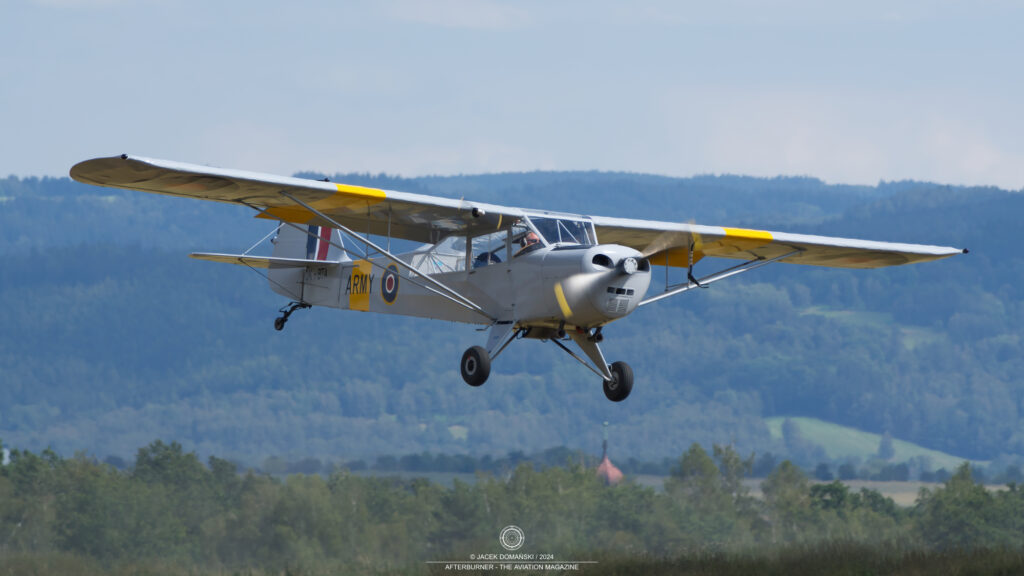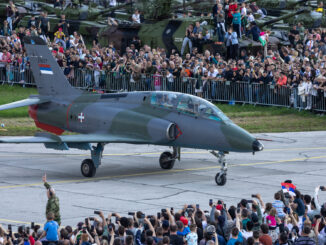 Taylorcraft Auster Mk V (c/n 1753, OK-BTA), flying display at Letecký den Cheb (Aviation Day Cheb), Cheb, August 2024.
Taylorcraft Auster Mk V (c/n 1753, OK-BTA), flying display at Letecký den Cheb (Aviation Day Cheb), Cheb, August 2024.
In 1930, Clarence Gilbert Taylor, the Chief Engineer of Taylor Aircraft Company developed a small, low-powered light utility aircraft. It was based on the earlier design of the company, known as Taylor Chummy or Arrowing Chummy, and featured a high-wing aeroplane with fixed undercarriage and two seats in tandem configuration. The new aircraft was designated Taylor Cub and created a base for an entire family of light aircraft, including the widely known Piper J-3 Cub.
In the mid-1930s, Taylor Aircraft Company was acquired by William Thomas Piper and renamed Piper Aircraft. However, C.G. Taylor preferred to go his own way in aircraft development. Therefore, he broke with the company and, in 1935, founded a new enterprise, Taylor-Young Airplane Company.
The first aeroplane designed by the Taylor´s new company received designation Taylor-Young Model A and was a redeveloped Taylor Cub, with seats in side-by-side configuration. In 1939, the company was renamed Taylorcraft Aviation Corporation and the aircraft changed its designation to Taylorcraft A.
Yet before the outbreak of the World War II, Taylor wanted to start selling the Model A in the United Kingdom. However, it turned out the design did not meet the requirements of British provisions related to civil aviation, which were much stricter than those in the United States. In consequence, the Model A was redesigned into a new aircraft, designated Taylorcraft Plus C. It was powered by Lycoming O-145-A2 engine, and twenty-three examples of that aeroplane were built, including the prototype.
When the war began, the Royal Artillery announced the demand for a light utility aircraft, suitable for the task of air observation post (AOP) to direct the artillery fire. In response for that need, Taylor proposed another redevelopment of the Model A, Taylorcraft Plus D.
The aeroplane was evaluated by the army authorities as capable for the AOP service. At least three examples of the Plus D were acquired by the Royal Air Force and deployed to France in 1940. In addition, most of the existing Plus C aircraft were commissioned. Their original Lycoming engine was replaced with Cirrus Minor I, the same as used with the Plus D version, and their designation was changed for Plus C2. Both were also commonly referred to as Auster I.
The Taylorcraft aircraft deployed to the continent did not participate in any combat operations and returned to the United Kingdom after the fall of France. In the meantime, the British military authorities decided that Stinson L-1 Vigilant would be the new AOP aeroplane and placed an order for one hundred aircraft of that type.
The Stinson aeroplanes arrived from the United States only in 1942. However, they were finally assessed as too big and heavy for the AOP duty. Therefore, the army authorities had no other option than the Taylorcraft aeroplanes. The Auster I returned to service and new order for one hundred aircraft was placed in the early 1942.
Initially, the aeroplanes from the aforementioned order had to be powered by the American Lycoming O-290 engine (Auster II). However, issues with their availability led to replacing the powerplant with the British de Havilland Gipsy Major, generating about 130 hp (Auster III).
Further variants of the aeroplane included Auster IV, a slightly bigger aircraft with three-seat cockpit, and Auster V, able to be flown under instrument flight rules.
During the World War II, the Auster was operated by army cooperation units of the Commonwealth and other Allied air forces, including Australia, Canada, Norway, the Netherlands and Poland. After the war, surplus aircraft were sold to several other countries, such as Burma (now Myanmar), Greece, Hong Kong, Indonesia, Israel, Libya and Pakistan.
In the Royal Air Force, the Auster aircraft remained on duty until the late 1950s, when the AOP service was largely taken over by helicopters.
The Auster Mk V featured within our Photo of the Week series was manufactured in 1945. The aeroplane was used by several British AOP squadrons until 1953, when it was retired from active service. Then, the Auster was sold to private owners and operated as G-ANHZ by Channel Airways Ltd. In the mid-1990s, the aircraft was sold to Switzerland, registered HB-EZJ and underwent full reconstruction.
In 2022, the aeroplane was acquired by its current owner from the Czech Republic. Nowadays, the Auster V carries the livery of No. 661 (AOP) Squadron RAF, the one with which the aircraft concluded its military service in the 1950s.



